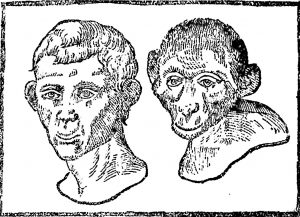5.7. Biological and Psychological Positivism
Brian Fedorek
Trait theories assume there are fundamental differences that differentiate criminals from non-criminals. These differences can be discovered through scientific investigations. Additionally, many early biological and psychological theories used hard determinism, which implies people with certain traits will be criminals.
Cesare Lombroso was a trained medical doctor in Italy when he had an epiphany. As he was performing autopsies on Italian prisoners, he started to believe many of these men had different physical attributes compared to law-abiding people and that these differences were biologically inherited. In 1876, five years after Darwin’s claim that some humans might be evolutionary reversions, Lombroso wrote The Criminal Man.[1] Lombroso claimed that 1/3 of all offenders were born criminals who were atavistic (evolutionary throwbacks).

He identified a list of physical features he believed to deviate from the “normal” population. These included an asymmetrical face, monkey-like ears, large lips, receding chin, twisted nose, long arms, skin wrinkles, and many more. Lombroso believed he could identify criminals simply by the way they physically looked. Even though his theory was widely rejected years later, it served as an example of the first attempt to explain criminal behavior scientifically.
A few decades after Lombroso’s theory, Charles Goring took Lombroso’s ideas about physical differences and added mental deficiencies too. In The English Convict, Goring claimed there were statistical differences in physical attributes and mental defects. The focus on mental qualities led to a new kind of biological positivism – the Intelligence Era. Alfred Binet, who created the Intelligence Quotient Test, believed intelligence was dynamic and could change. He wanted to identify youths who were not performing well in school. Unfortunately, H.H. Goddard, like many Americans at the time, believed intelligence was innate and static. That is, intelligence was fixed and could not change. Goddard gave IQ tests to sort people and those who scored too low were institutionalized, deported, or sterilized. He was an early advocate to sterilize those who were mentally deficient, especially “morons,” who were just smart enough to blend in with the normal population. In 1927, the United States Supreme Court in Buck v. Bell allowed the use of sterilization.
Even after Lombroso, Goring, and Goddard, contemporary research reveals intelligence is at least as critical as race and social class for predicting delinquency (Hirschi & Hindelang, 1977).[2] However, how we measure intelligence and how we define intelligence are based on our preconceived assumptions of intelligence. For example, is intelligence inherited? Is it related to the dominant culture? Or is it based more on the person’s environment? Each has a least some element of truth.
Modern biological theorists have revealed that biology plays a role in our behavior, but we cannot say how much or even how so. Twin studies and adoption studies examined the nature versus nurture debate. Both play a role in our behavior. It is more nature and nurture. Perhaps the question ought to be “How do our biological differences interact with our sociological differences?” There is not a crime gene per se, but some genetic variations are correlated with anti-social behaviors. However, those with genetic variations are not necessarily criminal because of genetics. Though it puts the individual at risk for such behaviors, a caring and supportive environment often mitigates the impact of the genetic code.
Proximate causes, such as neurotransmitters, hormones, the central nervous system, and the autonomic nervous system, have links to aggressive behavior too. However, many of these explanations have several possible causal paths. For example, we know people with higher testosterone levels engage in more aggressive behavior, but when people engage in aggressive behavior, their testosterone levels increase. We do not know which causes which.
What about criminal personalities? What about sociopaths and psychopaths? Gluecks (1950) determined there was no real criminal personality; instead, there were some interrelated personality characteristics that were clustered together.[3] Even after giving personality tests to criminals and non-criminals, there does not seem to be any logical relevance to understanding the causes of crime. However, there have been correlations between certain personality traits and criminal behavior. For example, impulsivity, lack of self-control, inability to learn from punishment, and low empathy have all been linked to criminal behaviors.
Consequently, none of these personality characteristics are criminal in and of themselves. The real danger is when a person has many of these personality characteristics. Capsi et al. (1994) found that constraint and negative emotionality, two super traits that contain several different characteristics, were “robust correlates of delinquency” (p. 185).[4]
In summary, researchers have been able to say that our biology and personality play a role in criminal behaviors, but we cannot say how much or to what degree. The characteristics of our social environment interact with our biology and personality. Human behavior is quite complex and it is difficult to determine the true causality of human actions.
- Lombroso, C. (1876). The criminal man. ↵
- Hirschi, T., & Hindelang, M.J. (1977). Intelligence and delinquency: A revisionist review. American Sociological Review, 42, 572-587. ↵
- Glueck, S., & Glueck, E. (1950). Unraveling juvenile delinquency. Cambridge, MA: Harvard University Press. ↵
- Capsi, A., Moffitt, T.E., Silva, P.A., Stouthamer-Loeber, M., Krueger, R.F., & Schmutte, P.S. (1994). Personality and crime: Are some people crime-prone? Replications of the personality-crime relationship across countries, genders, races, and methods. Criminology, 32(2). ↵

